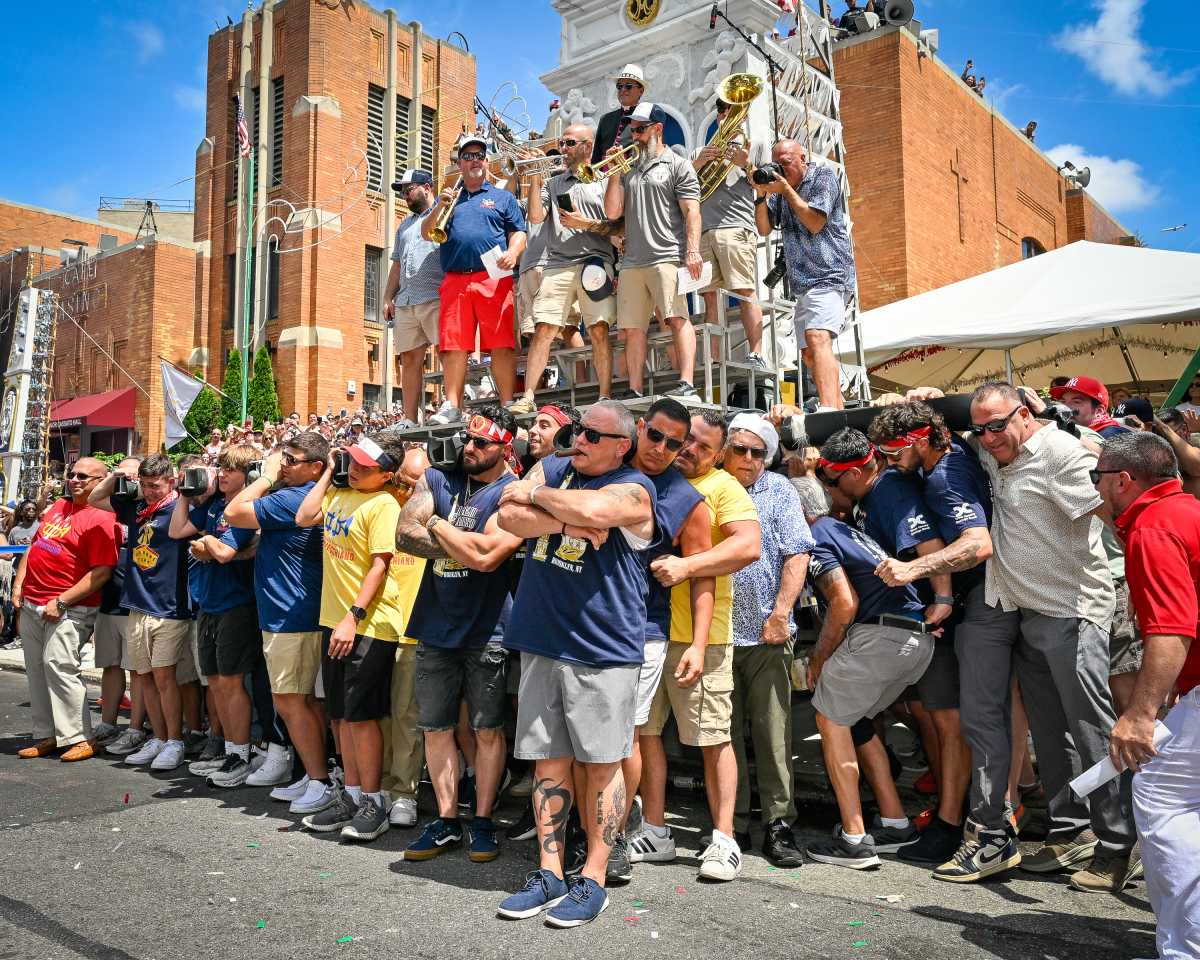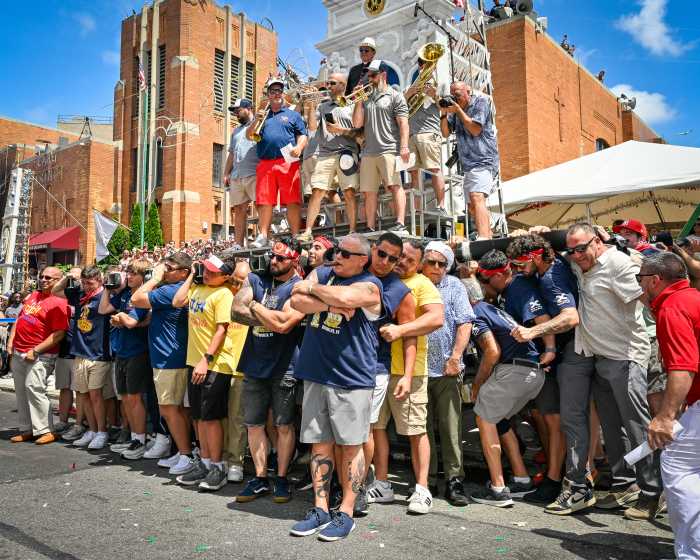
Rendering of the proposed tower. The dotted line indicates a building that would be permitted under the current zoning.
BY JOSH ROGERS | Do you hate towers more than you love schools and affordable housing?
That’s essentially the question, really the challenge, Howard Hughes Corp. is putting to community leaders with its latest plan to develop the South Street Seaport.
No wonder that after it was released two weeks ago, one of the opponents said both sides understand it’s time to “play hardball”
The fight over whether community needs such as a middle school were more important than reducing the size of the proposed tower (now almost 500 feet) by the South Street Seaport Historic District, was predictable, but community leaders were able to stave it off for most of the year with a new idea, the Seaport Working Group. The group included local politicians, community leaders and Hughes executives.
But with the changes, Hughes executives made it clear they were ready too say goodbye in effect, to the working group, which they nevertheless continue to praise for improving the plan.
Some of the “goodies” they added — most notably a middle school, 70 units of affordable housing, and a community center — were things the working group never asked for.

David Weinreb, Hughes Corp.’s C.E.O.
David Weinreb, C.E.O. of Hughes Corp., acknowledged that financially, it could be a wash to reduce the height of the building more than the 150 feet they’ve already done.
“We could build a lower building, we have to start taking away benefits,” he said two weeks ago.
Councilmember Margaret Chin, one of the leaders of the Seaport Working Group, said the firm was “adding a lot of benefits to the community. We just wanted revisions to the fundamental tower proposal.”
This week Weinreb didn’t give a full answer as to why his firm — under its own parameters — chose not to come closer to meeting the working group’s goal to eliminate the residential tower. He did say the affordable housing was added nearby as a nod to Mayor Bill de Blasio’s administration.
“We know that the administration is deeply committed to affordable housing so we left a number to accommodate that request,” Weinreb told Downtown Express Monday, immediately after the first meeting of Friends of the Seaport.
An official with the Economic Development Corp., which manages the city-owned Seaport properties, speaking on background, confirmed that there have been active discussions with Hughes about adding affordable housing.
During the meeting, Weinreb said Hughes Corp. was “completely ambivalent” about how to allocate its own estimated community investment of $305 million as long as roughly half is spent on the repair and infrastructure work necessary to activate the dormant sites.
“There’s a big bucket of money that can be spent to make the Seaport community better,” he told the mostly sympathetic crowd.
New Group
The new Seaport Friends group is made up mostly of Lower Manhattan parents who favor the Hughes project. It just formed, surprisingly, with the encouragement of Councilmember Chin after leaders told her they were frustrated with the anti-tower bias at other public meetings.
The founders — Joy Martini, Maria Ho, and Lisa Gorke — are FiDi mothers who argue the project will bring many needed benefits to the area, including resurrecting a decrepit area that otherwise would have no hope to get the necessary funds.
“If we’re going to have a conversation about preservation, please, let’s address the blighted buildings along South St.,” Martini said. “These rundown structures are a menace to growth and an absolute threat to public safety.”
She attacked the comparison to building a tower in Colonial Williamsburg, made frequently by Borough President Gale Brewer.
“Colonial Williamsburg is an attraction, not a community — populated by actors and tourists — not us, not residents,” she said.
Although there has been grumbling that the new group is a creation of the Hughes firm, by all appearances it looks to be a genuine and separate initiative.
That said, Friends of the Seaport’s effort does help Hughes’ desire to go beyond the working group and other tower opponents.
Poll Questions
On Wednesday, Hughes released some of the results of a survey of 405 Lower Manhattan residents. The results showed strong support, 84 percent, for the Hughes plan, but some raised serious questions about the objectivity of the poll, conducted by Global Strategy Group.
Jenifer Rajkumar, a Democratic district leader in Battery Park City, was one of the people who was surveyed Nov. 19, and she said it was clearly a “push poll” intended to get a specific result.
She said the tower was only mentioned in connection with the community benefits and the opponents were described as “a small group of activists.”
When shown some of Rajkumar’s notes on the poll, a Hughes spokesperson said they were “not entirely accurate,” without being any more specific.
According to Hughes, one of the poll questions was: “Do you support or oppose the redevelopment and revitalization of the South Street Seaport area, including redeveloping Pier Seventeen and refurbishing the historic district?”
The question is misleading in at least one sense, since Hughes’ plan to rebuild a new Pier 17 mall building was approved last year, and will presumably continue to proceed even if the current plan to redevelop the New Market Building with the tower and restore the Tin Building is rejected.
The poll was clearly an effort to confirm the corporation’s long-held belief that the number of tower opponents only appears to be large.
“A very vocal minority has been heard for years on this project,” Chris Curry, senior executive vice president of development for Hughes, told Downtown Express back in January, before the working group was formed. “What we haven’t heard from is all of the people who live here, don’t have time to come to neighborhood meetings, that don’t come out to City Council meetings or to Community Board 1 meetings or town hall meetings but still want to give us their input.”
Gregg Pasquarelli, the project’s chief architect, said although the tower is tall, it is also narrow, so it would have far less visual impact than a squat 350-foot building allowed under the site’s zoning.
That new zoning passed with the support of Chin, who will play a pivotal role in the new plan once the formal land use application is filed, perhaps early next year.
Before that can happen, Hughes will need approval by the city Landmarks Preservation Commission, which won’t begin reviewing the project until January at the earliest.
On Dec. 10, Community Board 1 will consider the landmarks application at a public meeting at St. Paul’s Chapel, 209 Broadway, at 6 p.m.
Chin for now, is opposed to the tower, but she did not repeat her opposition at the Monday meeting, also attended by Weinreb and Pasquarelli, in addition to tower-supporting Downtown parents.
She told the small crowd that she thought a compromise plan was likely down the road.
“We’re not there yet,” she said, “but if we keep on talking and discussing and negotiating… we’ll get there.”




































